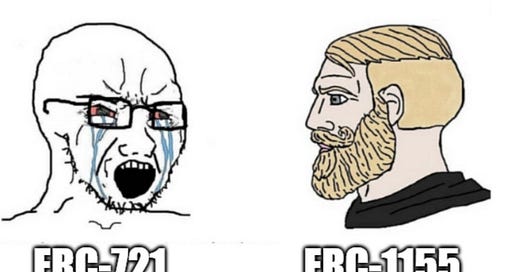As my general production of media moves towards the interests of creators and builders, I thought this topic on the two “main” NFT tokens quite important to cover.
Hope it’s useful. And good luck on any Otherside related activities this weekend!
If you missed the first BCheque Chat, a weekly interview series with the smartest thinkers, builders, and creators in this space, here’s my first chat with Brenden Mulligan (150k followers), Founder of PREMINT.
Will tell you here first: I am speaking with @osf_nft next week for a long chat about art, money, and how he thinks about creating value in this space. I will keep trying to bring the smartest and most influential people in the space in for thoughtful, relaxed conversations.

NFTs are simply tokens which represent ownership of something: from digital art, to digital clothing, to digital land.
BCheque, Paper 1: Why can NFTs be so valuable?
NFTs are tokens. Though not every NFT is the same type of token.
In this paper I will explain the differences between the two most common tokens you might encounter.
This is important for collectors who want to understand the type of token they are buying, and creators who want to understand why they might choose one token over another for their own NFTs.
ERC-721
These tokens are non-fungible. This means that each token is unique: they cannot be divided nor exchanged.
For example, this Pixel Vault Founder’s DAO token is an ERC-721 token.
Pixel Vault Founder’s DAO token: https://opensea.io/collection/foundersdao
There are approximately 5,900 tokens issued.
What makes it obvious that this is an ERC-721 (apart from the fact that OpenSea tells you in the details), is the fact that every ERC-721 has its own ‘Token ID”.
Here is the ‘Details’ section of two of the NFTs from this collection (which both look exactly the same as the image posted above).
Contract Address / Token ID: 0xd0A07a76746707f6D6d36D9d5897B14a8e9ED493 / 2192
Contract Address / Token ID: 0xd0A07a76746707f6D6d36D9d5897B14a8e9ED493 / 2229
In both of these instances, you can see the same “Contract Address”. This means the same contract issued both of these NFTs. However, the difference between these two NFTs is that they have unique Token IDs: 2192 and 2229, respectively.
As such, if you want your token to be entirely unique from every other token issued by a smart contract (even if it may look identical to every other token issued by a smart contract), then an ERC-721 is your best bet.
Bear in mind, however, that producing NFTs in this fashion and transferring this type of NFT is the more costly option.
ERC-1155
The point of an ERC-1155 token is that it can be governed by a smart contract which can govern a whole range of tokens.
This is in comparison with the ERC-721 smart contract, which can only govern one type of token at a time, and if you want to create different tokens you have to deploy an additional smart contract.
In this way, ERC-1155 tokens are more flexible. For example, you could use one smart contract to issue 7 different NFTs, all with the different supplies.
Think of this like a vending machine that holds a wide variety of soda, juices, and even snacks. A customer interacts with the machine using a single secure interface (inserting a coin, pressing a button), and the machine dispenses the goodies they have selected. In the same way, an ERC-1155 contract made for a game could contain a wide variety of items, from weapons and armor to health potions, magic scrolls, and more.
A helpful simile: the Enjin team created the ERC-1155 standard and described it like this
ERC-1155 tokens are also cheaper to produce and transfer.
Bear in mind, however, it is considered that ERC-1155s have less robust information and are harder to track in terms of ownership. (Broadly it can be said that collectors prefer ERC-721s, though that is sometimes debated.)
Here is a useful example of how ERC-1155s have been used.
Each of these planets are their own ERC-1155 NFT. They each have a different supply. They are all administered by the same smart contract.
When a particular NFT has no particular need for it to be distinguished from another (e.g. if one Jupiter NFT has no need to be distinguished from another Jupiter NFT), then the ERC-1155 choice makes sense.
In addition, there are thousands of NFTs issued here. It would have been much more costly to administer these as ERC-721s.
Final thoughts
It depends what you want from the NFT.
If you want something truly unique, entirely non-fungible, where the individuality (or even the token ID number) of a piece is important for creative or collectible reasons, then the ERC-721 token is probably the best bet. For this uniqueness, it can be slightly more costly to administer these tokens.
If you want flexibility to produce many different types of NFTs (fungible and non-fungible) from the same smart contract, and you want to do that at a large scale for a relatively cheaper price, then the ERC-1155 option is probably the best bet.
Have a great day,
B
Please do leave me any questions or thoughts here - I respond to every one!
And if you thought this was interesting, please consider subscribing to this Substack here and following me @BCheque1 and my company 32 Dreams on Twitter for more on NFTs and Web 3.0.
Disclaimer: The content covered in this newsletter is not to be considered as investment advice. It is for informational and educational purposes only.
I hold some of the NFTs mentioned in these newsletters.






